A whole lot of nothing
Scientists have discovered a huge expanse of nothingness in outer space.
By Emily Sohn
Larry Rudnick looked deep into outer space and saw—nothing. The discovery thrilled him.
“I came home, sat at the dinner table, and told my wife, ‘We found something pretty exciting today,'” says Rudnick, an astronomer at the University of Minnesota, Twin Cities.
What he found was the biggest expanse of nothing ever discovered. Inside the void, there are hardly any galaxies, planets, or black holes—just mostly empty space spanning an area that’s a billion light-years across.
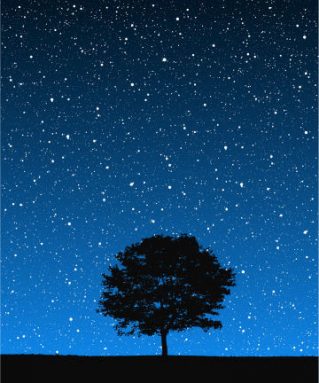 |
|
Stars and other objects fill most of the universe, but scientists were surprised recently to find a huge area of mostly empty space.
|
| iStockphoto.com |
To get a sense of how big that is, imagine standing outdoors on a night when the moon is full. Note how much space the moon takes up. The newly discovered void is 40 times as wide as the full moon from our view.
The discovery of so much nothingness helps explain some mysteries about the universe, Rudnick says. At the same time, the newly discovered void raises new questions about how galaxies, stars, planets, and other structures formed.
For a long time, astronomers thought that matter—which makes up everything in the universe—was distributed fairly evenly through space, with only small empty spaces and small spider-weblike structures. The new find calls that assumption into question.
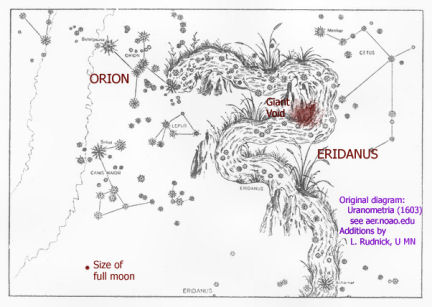 |
|
The newly discovered void is located in the constellation Eridanus, which represents a river in Greek mythology. Eridanus, illustrated here, lies near the constellations Orion, Canis Major, and Citus.
|
| Image from Bayer’s Uranometria (1661), courtesy of the Library of the US Naval Observatory; additions by Larry Rudnick. |
“Something in the theory [about the formation of structure in the universe] might have to change,” Rudnick says. In particular, the question of how matter has clumped together over time to form galaxies, planets, and other objects is once more open to discussion.
“It’s an important part of the story of how we got here,” he says.
A cold puzzle
Rudnick’s discovery began with observations made by other scientists about something called cosmic microwave background radiation, or CMB. The CMB is a glow of energy—or radiation—that flooded outer space about 13.7 billion years ago, after a huge, extremely hot explosion called the Big Bang brought about the formation of the universe.
The CMB still fills the universe, but it has changed. For one thing, it has drastically cooled. Just after the Big Bang, the glow was billions of degrees hot. Now, says Rudnick, it is just 3 degrees above zero kelvin (K). That’s equal to -454 degrees Fahrenheit or -270 Celsius. Zero kelvin is called “absolute zero.” And you can’t get any colder than that.
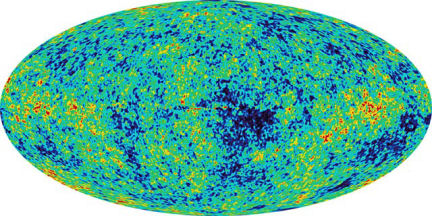 |
|
This “baby picture” of the universe shows the oldest light in the universe, produced just 379,000 years after the Big Bang, which occurred more than 13 billion years ago. “Warmer” areas look red. “Cooler” areas look blue. This was the first full-sky map of its kind and was made with data collected by the WMAP satellite.
|
| NASA |
Calculations show that most of the radiation is about the same temperature in all directions. In the scientists’ words, it’s “smooth.”
But not perfectly smooth. The CMB has small irregularities that are left over from around the time of the Big Bang. These irregularities include small spots that are slightly hotter or colder than average.
About three years ago, scientists made a puzzling observation that they couldn’t explain. In the CMB radiation, they noticed a cold spot that was especially cold.
They saw the cold spot in images taken by the Wilkinson Microwave Anisotropy Probe satellite. The satellite has been orbiting Earth since 2001 and scientists have been using it to map the CMB.
Ever since the discovery of that extracold cold spot, scientists have been debating its meaning. Because the CMB formed just after the birth of the universe and has been changing ever since, an oddity in one part of the radiation points to either “something very funny in that spot from the early universe or something funny that happened along the way,” Rudnick says.
Rudnick was working on a completely different project when he first heard about the supercold cold spot. He was feeling frustrated with his research, and his mind kept straying to the new mystery.
“I decided to look in the direction of this cold spot,” Rudnick says, “and see what I could see.”
Radio clues
To get a closer look, Rudnick looked at pictures of the spot taken by the Very Large Array (VLA), a radio telescope in New Mexico. Radio telescopes are huge, dish-shaped structures that collect radio waves, which can be converted into images that reveal details we can’t see with our eyes alone.
A small fraction of galaxies in the universe, for example, give off strong radio waves, Rudnick says. These galaxies, called radio galaxies, are distributed fairly evenly through space.
When he examined the VLA images, however, Rudnick counted 30 percent to 40 percent fewer radio galaxies than normal in the direction of the cold spot. Perplexed, he turned to University of Minnesota graduate student Shea Brown and astronomer Lilya Williams for insight.
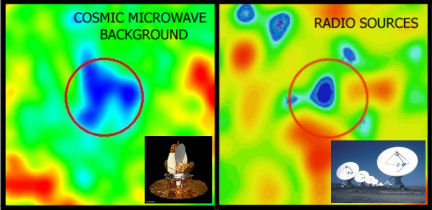 |
|
Rudnick and colleagues found the void by comparing two views of the same region of sky, shown above. Inside the circle on the left is a large cold spot detected by the WMAP satellite (inset). The image on the right shows a lower than average number of radio galaxies in the same area, as seen by a radio telescope called the VLA (inset).
|
| Rudnick et al., NRAO/AUI/NSF, NASA |
The only explanation for the unexpectedly low number of radio galaxies in the strangely cold spot, the team decided, was that the spot was actually a huge expanse of empty space. Rudnick and his colleagues think that most of the remaining galaxies seen in the direction of the cold spot probably lie in front of or behind the void.
Their reasoning went like this: Over billions of years, clumps formed in the matter of the universe, like cheese curds form in a vat of souring milk. (See “A Taste for Cheese“) Those dense, clumpy areas gave rise to planets, stars, galaxies, and other objects.
In these areas of higher density, the CMB becomes slightly hotter than average. But the clumping also left some areas with less matter and less density. In these areas, the CMB becomes slightly colder than average—which probably explains the extreme coldness of the newly discovered cold spot.
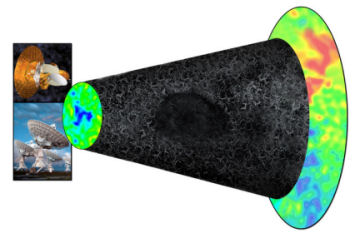 |
|
This illustration represents the CMB radiation moving through the universe, and changing temperature on the way—from the Big Bang on the far right, through a spider web of galaxies and clusters of galaxies, to us and our telescopes on the far left, which detect a cold spot (shown in blue). In the center of the diagram is a large void.
|
| Bill Saxton, NRAO/AUI/NSF, NASA |
Astronomers already knew that low-density holes existed in the universe. But, at a billion light-years across, this was by far the biggest void ever discovered.
To get a sense of how much bigger this void is than any other known holes, imagine exploring the surface of Earth, where only a few mountains top 20,000 feet (6,000 meters).
“If all of a sudden, you stumbled across a mountain that was 100,000 feet high, you’d go, ‘Oh my gosh, where did this come from?'” Rudnick says.
“You might say, ‘Scientists thought they understood how mountains were built, but can they explain this one?'” he adds. “That’s exactly what we’re asking here” about the big void.
Empty explanations
To explain the existence of the cold spot, Rudnick says, scientists in years past had proposed theories that involved “strange things going on in the early universe.”
Convinced that the cold spot formed right after the Big Bang, these scientists didn’t even consider that it might be a huge hole that developed over time. But a huge hole is a much simpler solution than the complicated theories scientists previously proposed.
“It’s an explanation for something that was odd,” says Ned Wright, an astrophysicist at the University of California, Los Angeles. “It’s an interesting result.”
Questions still remain. Based on what scientists know about structure formation in the universe, there should be only a 1 in 100,000 chance of finding a void this large, Rudnick says. So why is it there?
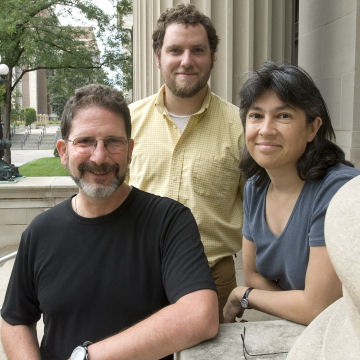 |
|
For a while, Larry Rudnick (left), Shea Brown, and Lilya Williams were the only scientists in the world who knew about the big void.
|
| Patrick O’Leary |
Figuring out how this huge void formed could help us better understand how the universe and its structures formed. Related research might help explain how mysterious substances called dark matter and dark energy interact with ordinary matter in space. (See “Strange Universe: The Stuff of Darkness“)
But that’s not all. Further work could also show how far away the void is and whether it’s shaped like a ball, a cigar, or something else, Wright says. It’s also not clear whether the void is totally empty, of if there is just much less matter there than expected.
Other scientists need to confirm Rudnick’s results. But for now, Rudnick is glowing from his own sense of discovery.
When he, Brown, and Williams figured out what they were looking at, the enormity of the discovery was exhilarating. “We were the only three people in the whole world that knew there was a hole there,” he says.
“That’s such an exciting moment to know that no one in the whole world knows what you know,” he says. “That’s one of the best parts of science. It doesn’t get any better than that.”
Going Deeper:







